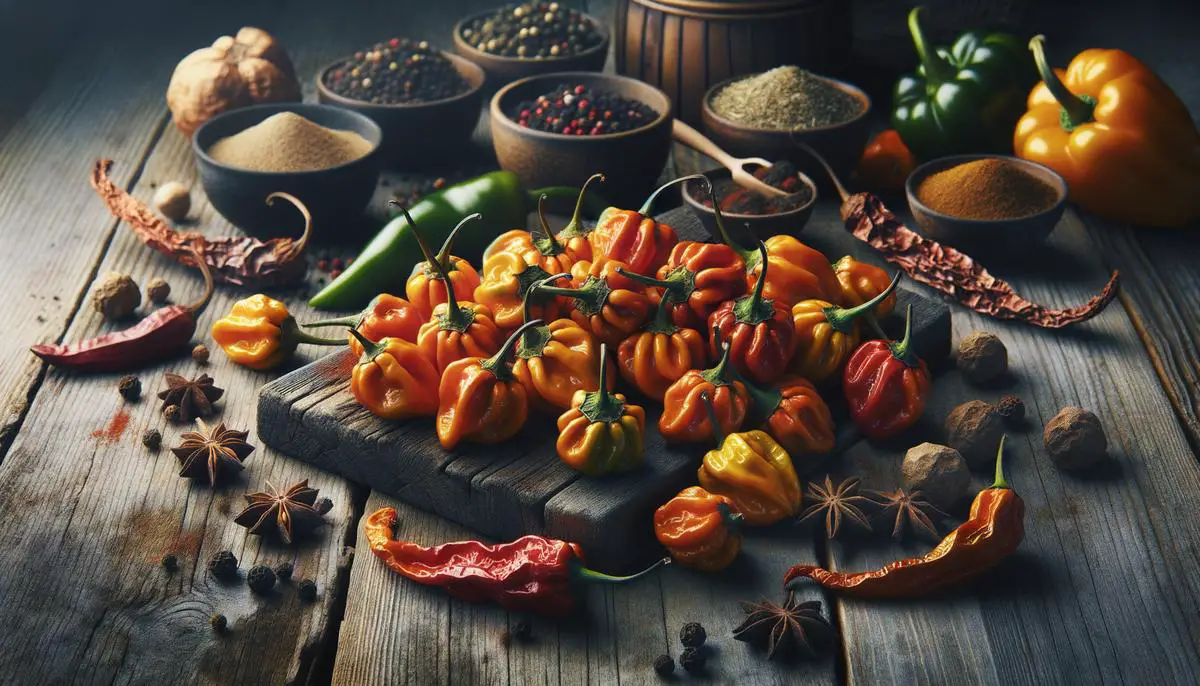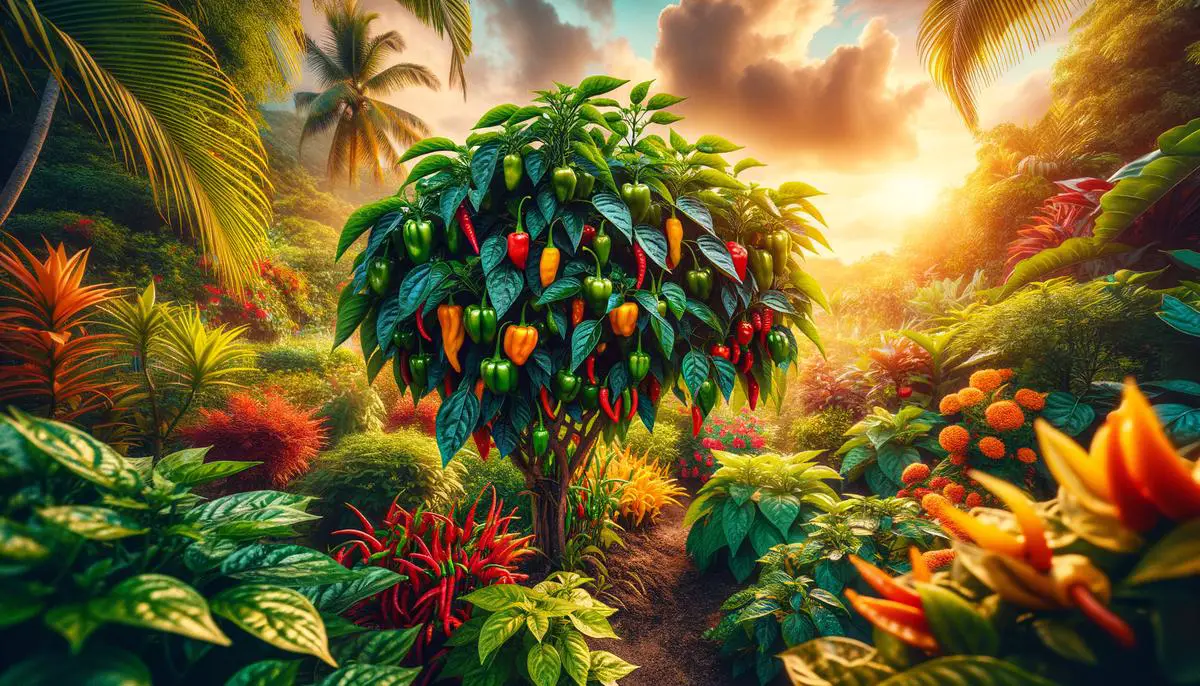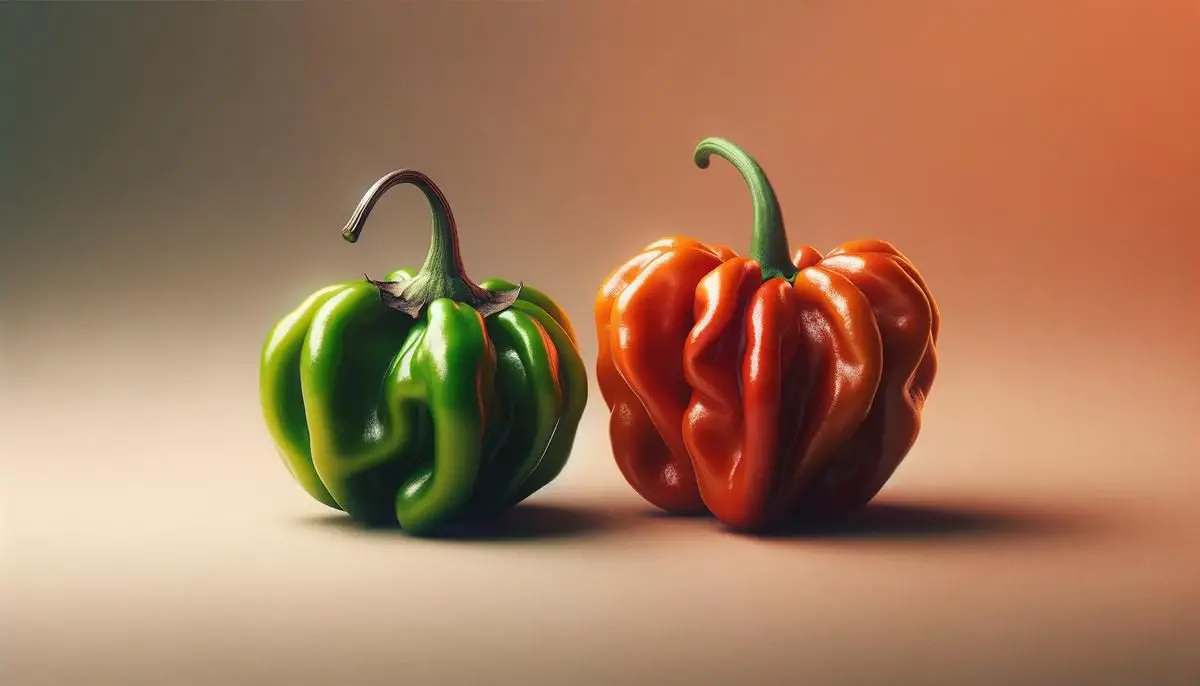
Origins and Cultivation
The cultivation of Scotch Bonnet peppers is an art form that embraces the warm, humid climate of their Amazonian origin. The peppers thrive in regions that mimic their original habitat, with Jamaica being one of the prime locations where they have flourished for centuries. Farmers in the Caribbean have mastered the balance of providing these peppers with rich, well-drained soil, ensuring they receive the right amount of sunlight and warmth.
One interesting aspect of growing Scotch Bonnet peppers is their adaptability yet specific need for a particular microenvironment. The ideal conditions mirror tropical climates, where heat and humidity kiss the plants daily, propelling their growth. It’s critical that they are watered regularly but also that the soil allows for proper drainage to prevent root rot.
The significance of Scotch Bonnet peppers in Caribbean agriculture extends beyond their culinary use. They are a symbol of cultural heritage, representing the spirit and resilience of the Caribbean people. Each pepper, from its vibrant color to its intense heat and fruity flavor, tells a story of migration, adaptation, and gastronomy.
Timing plays a crucial role in cultivation. The peppers enjoy a growing season that can extend up to a hundred days, positioning them as a hearty crop that requires patience and care. Harvesting these peppers when they’re brightly colored—ranging from yellow to red—means they are at their peak flavor and heat, adding zest to any dish they grace.
Farmers and gardeners alike who embark on the journey of growing Scotch Bonnet peppers learn quickly that these plants offer more than just spice; they carry a legacy. From seedling to harvest, cultivating these peppers is a process steeped in history and pride, contributing to the rich tapestry of Caribbean cuisine and culture.

Flavor Profile and Culinary Uses
The distinctive flavor profile of Scotch Bonnet peppers is a dance of fire and sweetness. These peppers command attention not just because of their formidable heat, striking a range of 100,000 to 350,000 on the Scoville Heat Index, but equally for their rich, complex flavors that unfold with every bite. What makes Scotch Bonnets truly unique is their ability to bring a deep, fruity essence to dishes, reminiscent of apricot, cherry, and tomato, all swirled together with a hint of smoky undertones.
Their heat and fruity flavor make these peppers an irreplaceable ingredient in the Caribbean culinary palette. The balance of sweetness and spice elevates traditional dishes, merging seamlessly with other spices and fresh ingredients to create a symphony of flavors.
Scotch Bonnet peppers play a pivotal role in jerk seasoning. This quintessential Jamaican blend is a powerhouse of allspice, thyme, garlic, and minced Scotch Bonnet peppers. The peppers infuse the marinade with their heat and introduce a layer of fruity, citrusy undertones that brilliantly complements the smokiness of grilled meats. Whether it’s chicken, pork, or seafood, jerk seasoning with Scotch Bonnet peppers transforms ordinary ingredients into an extraordinary culinary experience.
Beyond jerk seasoning, Scotch Bonnet peppers find their way into an array of Caribbean dishes, showcasing their versatility. Jamaican pepper sauce, a staple condiment across the islands, blends Scotch Bonnet peppers with vinegar, carrots, and spices, resulting in a fiery accompaniment that adds zest to any meal.
The peppers are also skillfully incorporated into mango salsas, presenting a tantalizing contrast between the mango’s sweetness and the pepper’s heat. Such pairings underscore the Scotch Bonnet’s compatibility with fruity flavors, unveiling its potential beyond mere spiciness. In curries and stews, they quietly simmer, infusing dishes with their characteristic heat while mellowing out to allow a hint of their fruity essence to shine through.
Due to their intense heat, culinary experts advise proceeding with caution. Incorporating the peppers whole or in large slices into simmering pots allows them to impart flavor without overwhelming dishes with heat. For the bold, mincing the peppers fine can elevate heat levels, converting meals into fiery experiences.
Scotch Bonnet peppers stand as titans in Caribbean cuisine, defining and refining the region’s flavor profile. Their combination of heat and sweet fruitiness, coupled with their versatility in cooking, underscores their uniqueness. Cooking with Scotch Bonnet peppers requires respect for their potency and an appreciation for their background – making them not just an ingredient but a messenger of Caribbean culinary history and heritage.
Nutritional Benefits and Precautions
The allure of Scotch Bonnet peppers extends beyond their culinary prowess; these fiery gems are also packed with nutritional benefits that can enhance one’s health. The connection between spice and well-being is deeply rooted, revealing the balance between pleasure and precaution in consuming these potent peppers.
Rich in vitamins A and C, Scotch Bonnet peppers are allies in bolstering the immune system1. Vitamin A is crucial for maintaining healthy vision, skin health, and organ function, while vitamin C is an antioxidant that helps in repairing tissues, aiding in the absorption of iron, and promoting proper immune system function. The capsaicin in Scotch Bonnets, the compound that bestows their heat, has been associated with boosting metabolism, providing potential weight loss benefits, and may even have analgesic properties that help in pain relief2.
Scotch Bonnet peppers also impart a wealth of other nutrients including potassium, which aids in maintaining electrolyte balance and cardiovascular health, and dietary fiber, which is essential for digestive health. This makes these peppers powerful boosters to your diet, marrying flavor with function in each fiery bite.
When handling Scotch Bonnet peppers, one must tread carefully to avoid the less pleasant side of their fiery nature. The capsaicin that gifts these peppers their heat can cause irritation to the skin, eyes, and mucous membranes. For those cooking with these peppers, it is wise to wear gloves as a protective barrier against capsaicin’s burn. Cutting and deseeding these peppers under a running hood or in a well-ventilated area can prevent irritation from volatile capsaicin molecules in the air.
For those tasting dishes with Scotch Bonnet peppers for the first time or who are sensitive to spice, it’s advisable to start with a small amount due to their considerable heat. Consuming dairy products like milk or yogurt can offer relief, as they contain casein which can help neutralize capsaicin’s effects3.
Should capsaicin make contact with your hands despite precautions, washing them with an oily substance, followed by soap and water, can help dissolve and remove the irritant. In the event of eye contact, rinsing with cold water or utilizing saline solutions is advisable.
Engaging with Scotch Bonnet peppers is not just about unleashing the potential of their heat and flavors upon our meals. It’s a journey of understanding their dual nature as both harbinger of zest and emblem of health benefits. By embracing the necessary precautions and respecting their potency, we can fully enjoy the numerous assets these peppers have to offer. Scotch Bonnets encapsulate the essence of wisdom in the proverbial phrase: to handle with care – enriching our plates, palates, and well-being.
Comparison with Other Peppers
In the kingdom of fiery fruits, where capsicum reigns, the Scotch Bonnet occupies a noble position, often mentioned alongside its close cousin, the Habanero. Each pepper varietal, from the Ghost pepper to the Trinidad Moruga Scorpion, has its own unique set of ingredients in the flavor and heat department. To truly appreciate the Scotch Bonnet’s place in this spicy spectrum, a comparative analysis with other similar hot peppers, particularly the Habanero, is essential.
Heat Factor: A Fiery Equation
The Scoville scale serves as our yardstick in understanding the heat level of these peppers. Both Scotch Bonnets and Habaneros sprint within the 100,000 to 350,000 Scoville Heat Units (SHUs) range. But is the heat experienced by the palate merely a matter of numbers? The consensus nudges towards complexity. While both can claim a capsaicin-rich heritage, resulting in a profound sizzling sensation, anecdotal culinary accounts suggest subtle variabilities. Certain Scotch Bonnet varieties may impart a rush of warmth that peaks swiftly and dissipates, as opposed to some Habanero types presenting a lingering tingle.
Flavor Notes: Beyond the Burn
Delving deeper past their blistering facade, the true character of these peppers emerges through their varying flavor profiles. Habaneros carry a smoky veil, flavored with a fruity charm that edges into notes of apricot or even apple. These subtleties of taste paint a myriad landscape of culinary possibility.
The Scotch Bonnet, however, wears its flavors louder. Aside from its heat, it boasts a sweet yet tangy essence with strong hints of cherry, tomato, and even a citrus twist. In this realm, the Scotch Bonnet differentiates itself as not just another chili pepper but as a poignant symphony conductor orchestrating layers of flavors.
Culinary Uses: A Spicy Narrative
From the rudimentary to the elaborate gastronomical experiments, the culinary applications of these chilis swell beyond bound. Habaneros, with their floral and smoky overtones, have inspired a generation of hot sauces and salsas, grounding themselves as mainstays in Mexican and Tex-Mex cuisines. They offer their warmth to seas of guacamoles and quesadillas and imbue meats with captivating brackets of flavors when used in marinades.
The Scotch Bonnet, drenched in Caribbean heritage, is the heartthrob of jerk seasonings, pepper sauces, and mango salsas adorning tables from Jamaica to Barbados. In these territories, to conceive a jerk marinade sans Scotch Bonnet is akin to a Shakespearean tragedy lacking in drama. Its fruity tartness is ingeniously leveraged in concoctions that require a zesty punchline, drifting effortlessly into culinary creations where it anchors itself as indispensable, embodying the spirited Caribbean zeal.
Conclusion: Spicy Kinship with Distinction
Through this analysis, one discerns a rich tapestry of flavor, heat, and cultural identity wrapped in the vibrant forms of Scotch Bonnet and Habanero peppers—their similarities weave them closely together in the capsicum clan, yet their distinct personalities resonate profoundly within their native cuisines. Whether one courts the smoky whispers of a Habanero or the fruity verve of a Scotch Bonnet, their roles surpass mere ingredients to become storied ambassadors representing generations of tradition and culinary innovation.
In embracing these fiery peppers, we open gates to worlds where flavor knows no bounds, and every bite is a narrative resplendent with heat, history, and a kaleidoscope of tastes. Both belong to esteemed positions in the culinary universe, with the Scotch Bonnet imbued with a certain magic typical to Caribbean shores—highlighting its majesty and delineating its echelon in the spicy realms of peppers.

The Scotch Bonnet pepper adds more than just spice to dishes; it serves as a beacon of Caribbean heritage, embodying the warmth, resilience, and zest for life of its people. Through understanding its origins, cultivation, and culinary uses, we gain a deeper appreciation for this remarkable pepper and its role in enriching our culinary landscapes.
- Pawar SS, Bharude NV, Sonone SS, Deshmukh RS, Raut AK, Umarkar AR. Chillies as food, spice and medicine: a perspective. Int J Pharm Biol Sci. 2011;1(3):311-318.
- Sharma SK, Vij AS, Sharma M. Mechanisms and clinical uses of capsaicin. Eur J Pharmacol. 2013;720(1-3):55-62. doi:10.1016/j.ejphar.2013.10.053
- O’Mahony R, Frías J. Casein-derived bioactive peptides as functional food ingredients for the management of type 2 diabetes. Trends in Food Science & Technology, 2022, 122:18–32. doi:10.1016/j.tifs.2022.01.014



